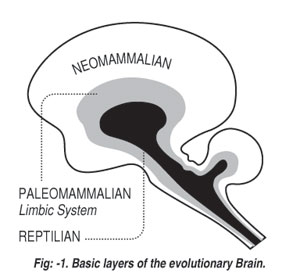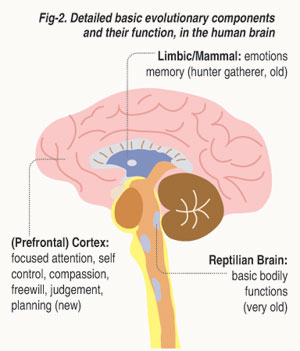Sunday Times 2
Buddhism, brain networks and the science of ‘Self’
View(s):By Dr Channa Ratnatunga
The scientific background to every spiritual journey is unique, as it deals with a unique personality—the ‘I’ in all of us. Yet there is a commonality of things we all long for: a calmer mind, ‘an open heart’, and the wisdom to meet life with clarity and compassion. The underlying science of achieving this state of mindfulness involves non-judgemental attention to the present-moment experience, ‘Anatta’, and is as given below.
Primordial conditioning for survival and procreation to maintain the species is intrinsic in all humans due to the reptilian and pre-mammalian components of their basal brain (see Figure 1). The human brain reflects (carries) within its neuronal nets these evolutionary biological pathways and the inherent proclivities and behaviour of its animal past.
The brain’s neuroplastic process then adds to this conditioning during life. Neuroplasticity is the brain’s remarkable capacity to reorganise itself by forming new neural connections throughout life. The brain can change its structure and function in response to both positive and negative experiences.
This is the Neuroplasticitic-Self, created by the brain. The brain’s ability to form these self-constructs is linked to survival. It is the Neuroplasticitic-Self that is called the Conditioned Self. The Conditioned Self is a natural phenomenon that is seeded in all mankind for survival. Included in this inherited security network, to reiterate, is the primordial brain and its reflexes for survival and procreation. The “I” and the narrative “me” are the prime actors of the Conditioned Self, the “I” refers to our subjective sense of self, the feeling of being a conscious individual with agency (ability to act). The “narrative me” is the story we construct about ourselves, our past, and our identity. It’s how we make sense of our experiences and create a coherent sense of self.
This combined intrinsic process is a natural reality in all beings. It is ‘the Conditioned Self’, a unique personality that grows in the brain networks from childhood to old age, a process adapting with experience to ensure the ‘being’s survival in whatever environment, both external and internal, the being finds him/herself in. It is what we all accept as Self. Promulgated in Hinduism as the Atta and in Christianity as the Soul, it is not an eternal entity, but it is a natural process ingrained in the brain for survival.
The process is located (continuously trans-scripting itself in the tissues) in the Pre-Frontal Cortex and the Midline Cortical Structures of the brain. It is dominantly in the neurones of the Default Mode Network (DMN) of the brain (see Figure 2).
The DMN is active whilst ruminating on self-‘baggage’ of the past, the ‘I’ or the narrative ‘me’, as shown by functional magnetic resonance.
Imaging (fMRI) studies are done while doing so, i.e., ruminating. The DMN is a survival network, and most humans are in it for much of the time.DMN is emotion-related through its connection with the Limbic System of the Pre Mammalian Cortex (see Figures 1 & 2). This cortex of the brain evolved when the egg stage evolved to a period of gestation, which became necessary for lifeforms (i.e., mammals). The ‘family’ was then born, hence the care of the young with its intrinsic emotions, e.g., love.
Emotion entails the creation of Kamma. For example, any intrusion into one’s ‘personal space’ is bound to progress from irritation, annoyance, ill will, anger, hatred, rage, revenge, etc., as a mental sequence. Another delusional mental sequence could be desire, jealousy, attachment, greed, craving, etc. Underlying all would be the deeper thoughts of survival, the sine qua non of all life forms.

Fig. 1. Basic layers of the evolutionary brain
Another brain network of neurones, which forms the Central Executive Network (CEN), a more task-related network, is located in the Dorso-lateral Pre-Frontal Cortex the brain. The CEN regulates the DMN. This has been shown to occur via a white matter (Connectome) tract called the Uncinate Fasciculus.
The Central Executive Network of the brain is a task-related network. That is, being aware of only the present moment, i.e., the ‘now’, Mindful Meditation (Vipassana Bhavana), if done persistently, not only emulates a ‘task’ but also creates a trait as different from a mere state. Such practitioners have been shown to attenuate the DMN and get liberated from the Conditioned Self, the aspiration of every Buddhist.
The Dalai Lama facilitated collaborations with the Waisman Laboratory—Centre for Imaging Healthy Minds at the University of Wisconsin-Madison, USA—by bringing Tibetan monks with over 10,000 hours of meditation practice for fMRI studies. Imaging was done while meditating. These have revealed how high-order meditation can alter the brain function by attenuating the DMN, so providing neuroscientific support for this core insight by the Buddha of emancipating from one’s conditioned self, i.e., Annatta.
(Details of this information are in print in my 150-page book Buddhist Philosophy and Neuroscience, available at all Sarasavi bookshops and BPS-Kandy for Rs 800. The revenue is entirely used to fund the Migara Trust Fund. Which funds needy medical students of the University of Peradeniya.
A companion volume,
‘The Conditioned Self’, is due out soon.)

Fig. 2. Detailed basic evolutionary components and their function, in the human brain

